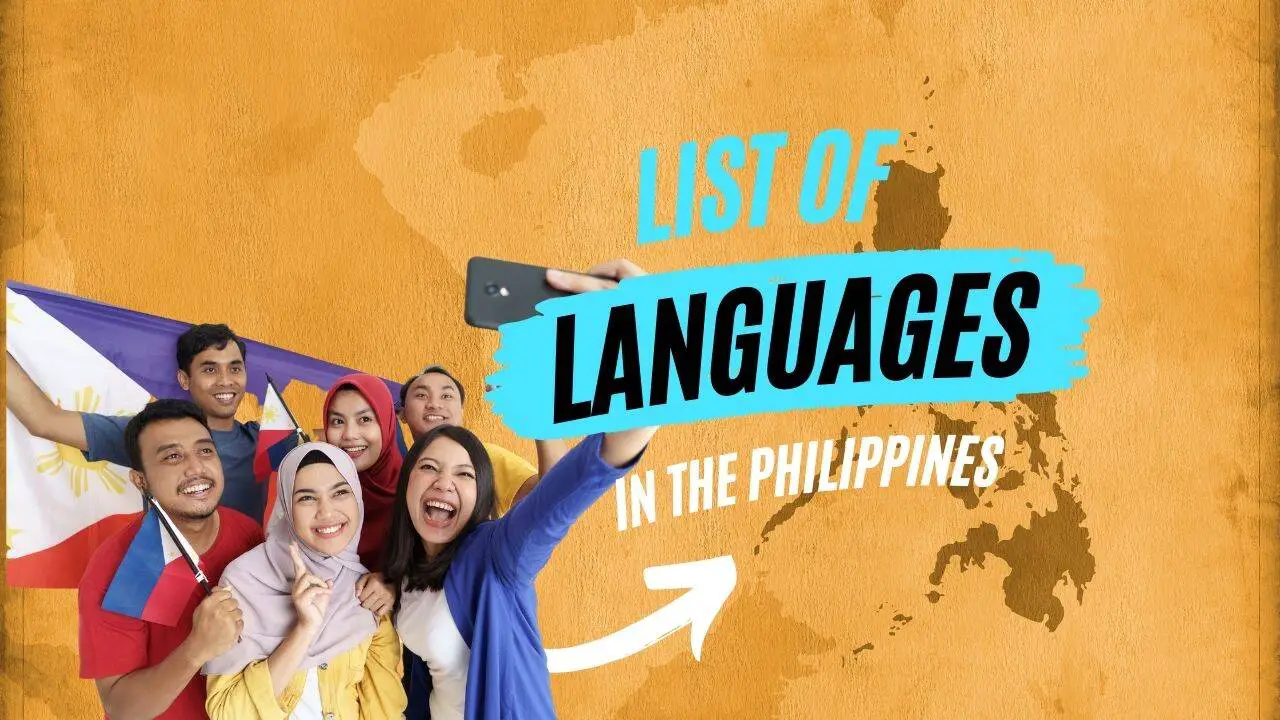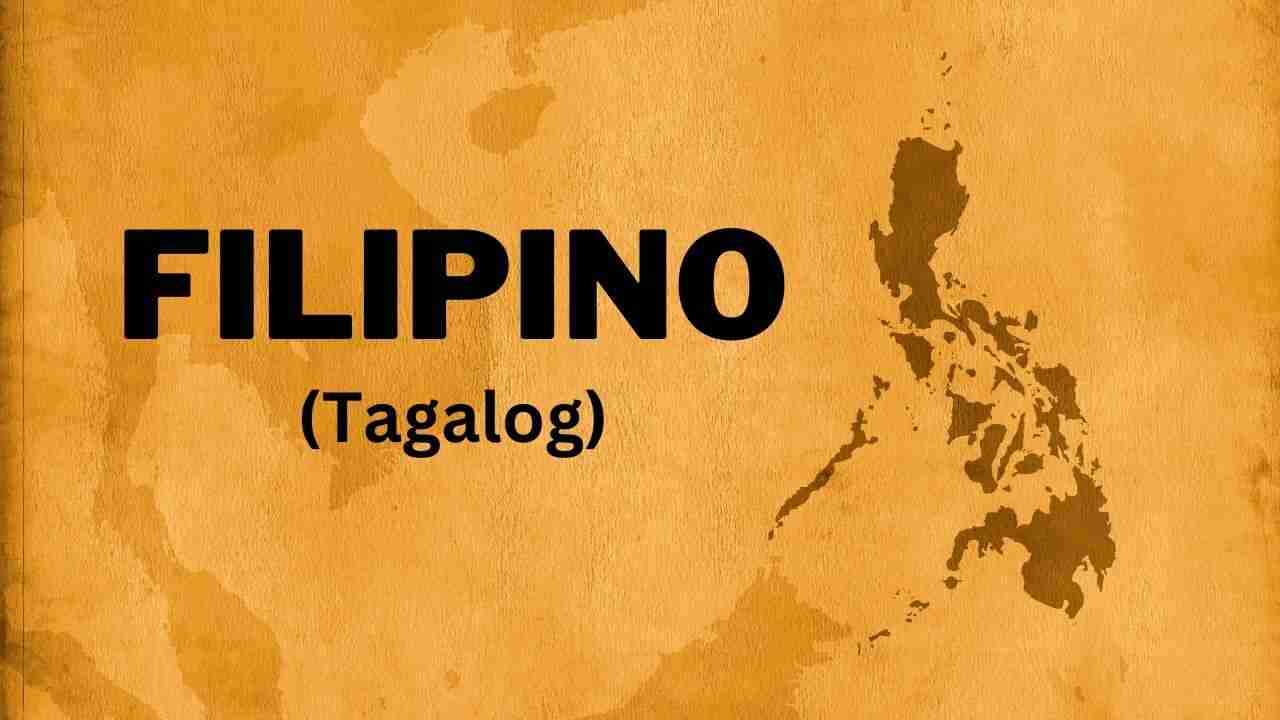Are you looking for a complete list of languages in the Philippines? This page compiles all the 170+ living languages in the country and their significant information.
The Philippines has a more than 114 million population, and they speak more than 170 languages. That’s expected because it is part of the largest archipelago in the world, the Malay archipelago.
This article shares the country’s most used or spoken dialects – active, endangered, and extinct languages. You can also share your favorite in the comments or those you’re interested in learning.
What is the national and official language in the Philippines?
Filipino is our national language. It is also known as Tagalog and is widely spoken nationwide. A rich history of cultural interactions and colonial influences of Malay, Spanish, and English influences Filipino vocabulary. The Filipino language is used in schools, offices, and media platforms in the Philippines.
The Tagalog language was not used as a national language until 1937, but most Filipinos already spoke the language at that time.
Importance of the Filipino Language
The Filipino language is very significant in shaping the identity of the Philippines as a nation and the Filipino people. It plays a fundamental role in promoting unity, boosting economic development, and preserving cultural heritage, art, and literature. It immortalizes the existence of the Philippines and its people.

Top 10 Most Spoken Languages in the Philippines
1. Filipino (Tagalog)
Filipino is one of the most spoken languages in the Philippines. It is based on Tagalog, the language spoken in the capital, Manila, and nearby provinces. Around 25% of the Philippine population considers Tagalog as their mother tongue. Filipino is utilized as either the primary or secondary language by over 50% of all Filipinos.
Filipino language is used in schools, newspapers, TV shows, movies, social media, SMS, blogs, videos, and other online platforms. It has evolved and produced numerous variants and styles over the years. The Philippine government proclaimed August 1-31 to celebrate Buwan ng Wika (National Language Month) to promote our national language, Filipino.

2. English
The Philippines is among the largest English-speaking countries in the world. English is widely used in business, education, government, and media. It has become an essential tool for communication both domestically and internationally. Many Filipinos are fluent in English, making interacting with foreigners and participating in global affairs easier.
3. Cebuano (Bisaya, Visayan)
Cebuano, also known as Visayan or Bisaya, is an indigenous language many Filipinos speak. It is primarily used in the Visayas and Mindanao regions. Cebuano has various dialects across different areas but remains mutually intelligible among speakers. This language is vital in promoting local culture and identity within these regions.
4. Kapampangan (Pampango)
Kapampangan is primarily spoken in the province of Pampanga and parts of the neighboring provinces of Tarlac, Bataan, and Bulacan. It is classified as a Central Luzon language and is part of the Austronesian language family. Despite being a regional language, Kapampangan has recently gained recognition and preservation efforts. It is taught in schools and universities, and there are ongoing initiatives to promote its use and appreciation.
5. Ilocano
IIlocano is a native language primarily spoken in Northern Luzon, particularly the Ilocos region. It is also widely used by Filipino communities living abroad. IIlocano has a long and fascinating history, too. It’s actually one of the oldest languages in the Philippines, dating back to when the Spaniards discovered the Philippines in the 16th century.
6. Bicolano
Bicolano, also known as Bikolano, is a language in the Bicol region. More than 4 million people speak it. The language has several dialects, including Albay Bicolano, Masbateño, and Rinconada Bikol. This native language continues to be spoken and celebrated by the Bicolano people in their everyday lives and various cultural events.
7. Waray-Waray
Waray-waray language is primarily spoken in the Eastern Visayas region, particularly in the provinces of Samar and Leyte. It is one of the major languages in the Philippines and is also known as Waray, Binisaya nga Winaray, or Lineyte-Samarnon. Waray-waray is a member of the Visayan language family and is closely related to Cebuano and Hiligaynon.
8. Ilonggo (Hiligaynon)
Ilonggo, or Hiligaynon, is a native language in Western Visayas. It is primarily spoken in the provinces of Iloilo, Negros Occidental, Guimaras, and Capiz. With over 9 million speakers, Ilonggo plays an essential role in the cultural identity of the Ilonggo people.
According to the International Dialects of English Archive, the name Hiligaynon came from the native people who lived along the coasts, also known as the Ilawod people. They were referred to as “Yligueynes” by the Spanish explorer Miguel de Loarca.
9. Pangasinense
The Pangasinense language is widely spoken in the province of Pangasinan. It is classified as one of the Malayo-Polynesian languages. Many people in the Philippines also speak Pangasinense, including the Northern part of Tarlac, southwest of La Union, and other communities in Nueva Ecija, Zambales, Nueva Viscaya, and Benguet.
10. Maguindanaon
Maguindanaoan is an ethnic language spoken by most of the population of Maguindanao and is part of the larger Moro ethnic group. The Maguindanaon people have a strong sense of community and are known for their hospitality and generosity. They deeply respect their ancestors and practice Islamic traditions and customs.
An Overview of the Stable Languages Spoken in the Philippines
- Agusan Monobo
- Agutaynen
- Aklanon
- Amganad Ifugao
- Ata Manobo
- Balangao
- Balangingih Sama
- Bantoanon
- Batad Ifugao
- Baybayanon
- Binongan Itneg
- Binukid
- Botolan Sambal
- Brooke’s Point Palawano
- Buhid
- Buhi’non Bikol
- Butbut Kalinga
- Calamian Tagbanwa
- Caluyanun
- Capiznon
- Casiguran Dumagat Agta
- Central Bontok
- Central Cagayan Agta
- Central Palawano
- Central Sama
- Central Subanen
- Chavacano
- Cotabato Manobo
- Cuyonon
- Davawenyo
- Dibabawon Manobo
- Eastern Bontok
- Filipino Sign Langauage
- Gaddang
- Ga’dang
- Hanunoo
- Ibaloi
- IbanagIlianen Manobo
- Inabaknon
- Inonhan
- Iranun
- Iraya
- Isnag
- Itawit
- Kagayanen
- Kalanguya
- Kankanaey
- Karao
- Kasiguranin
- Keley-i Kallahan
- Kinabalian
- Kolibugan Subanon
- Koronadal Blaan
- Libon Bikol
- Limos Kalinga
- Lubuagan Kalinga
- Mabaka Valley Kalinga
- Maeng Itneg
- Mag-Indi Ayta
- Majukayang Kalinga
- Malaynon
- Mandaya
- Mansaka
- Mapun
- Masadiit Itneg
- Matigsalug Manobo
- Minamanwa
- Miraya Bikol
- Molbog
- Moyadan Itneg
- Northern Binukidnon
- Northern Catanduanes Bikol
- Northern Kankanay
- Northern Sorsoganon
- Northern Subanen
- Pahanan Agta
- Pamplona Atta
- Pangutaran Sama
- Paranan
- Porohanon
- Rajah Kabunsuwan Manobo
- Rinconada Bikol
- Romblomanon
- Sangil
- Sarangani Blaan
- Sarangani Manobo
- Southern Binukidnon
- Southern Bontok
- Southern Catanduanes Bikol
- Southern Kalinga
- Southern Sorsoganon
- Southern Subanen
- Southwest Palawano
- Tagabawa
- Tagakaulo
- Tagbanwa
- Tandaganon
- Tanudan Kalinga
- Tawbuid
- Teduray
- Tuwali Ifugao
- Vanaw Kalinga
- West Albay Bikol
- Western Bukidnon Manobo
List of Institutional Languages in the Philippines
- Cebuano
- Central Bikol
- Filipino
- Hiligaynon
- Ilocano
- Ivatan
- Kamayo
- Kapampangan
- Kinaray-a
- Maguindanaon
- Maranao
- Masbatenyo
- Mayoyao Ifugao
- Pangasinan
- Southern Sama
- Surigaonon
- Tagalog
- Tausug
- Tboli
- Waray-Waray
- Yakan
List of Endangered Languages in the Philippines
- Abellen Ayta
- Adasen
- Alangan
- Ambala Ayta
- Arta
- Ata
- Ati
- Bagobo-Klata
- Bangon
- Bantayanon
- Batak
- Bogkalot
- Bolinao
- Butuanon
- Central Tagbanwa
- Dupaninan Agta
- Eastern Subanen
- Eskayan
- Faire Atta
- I-wak
- Ibatan
- Inagta Alabat
- Inlaud Itneg
- Isinay
- Kagan Kalagan
- Kalagan
- Katubung Agta
- Kinamiging Manobo
- Mag-antsi Ayta
- Magbukun Ayta
- Manide
- Mt. Iraya Agta
- Mt. Iriga Agta
- Northern Alta
- Northern Bontok
- Obo Manobo
- Pudtol Atta
- Ratagnon
- Remontado Dumagat
- Sambal
- Sorsogon Ayta
- Southern Alta
- Southwestern Bontok
- Sulod
- Tadyawan
- Umiray Dumaget Agta
- Western Subanon
What are the Extinct Languages in the Philippines?
- Dicamay Agta
- Villa Viciosa Agta
Historical Influence on Languages and Dialects of the Philippines
The languages spoken in the Philippines have been shaped by influences, over the centuries. Spanish colonization, American colonization and the presence of foreign traders all played a role in shaping the linguistic landscape of the country.
Spanish Colonization greatly influenced Philippine languages through loanwords and grammatical structures.
During the three-century rule of Spain, the Spanish language greatly influenced dialects by introducing loanwords that enriched their vocabulary. Words related to religion, government, food, and everyday objects were borrowed from Spanish and incorporated into Filipino languages.
Apart from loanwords, Spanish also influenced the structures of languages. Many indigenous languages adopted aspects of grammar like verb conjugations and sentence structure. This influence can still be seen today in Filipino languages such as Tagalog and Cebuano.
American Colonization introduced English as an official language alongside Spanish during that period.
After Spain’s defeat in 1898, the United States assumed control over the Philippines as rulers. This Colonization led to shifts in language policies. English was introduced as a language alongside Spanish during this era.
English swiftly gained importance due to its connection with education and employment prospects. It became widely utilized in schools and government institutions. The influence of English can be seen not only in formal settings but also in everyday conversations among Filipinos.
Indigenous Philippine languages have retained their unique features despite external influences.
Despite external influences from colonial powers, indigenous Philippine languages have retained their unique features and characteristics. Various ethnic groups in the Philippines continue to speak these native tongues.
Indigenous Philippine languages are known for their rich oral traditions and cultural significance. They reflect the diverse heritage of different regions within the country. Each native language has its own distinct vocabulary, grammar rules, and pronunciation.
Chinese traders’ presence contributed to some Chinese loanwords incorporated into local dialects.
The presence of Chinese traders in the Philippines has also left its mark on the country’s linguistic landscape. Over the centuries, Chinese traders brought with them their language and culture, resulting in the incorporation of Chinese loanwords into local dialects.
Chinese loanwords are particularly evident in Philippine languages spoken in areas with a significant Chinese population. These loanwords often relate to commerce, food, and traditional practices. They testify to the historical connections between China and the Philippines.
Immigrant Languages in the Philippines
Various immigrant languages are spoken by expatriate communities residing in the Philippines. These foreign languages reflect the multicultural nature of the country and its openness to foreign cultures.
Major Immigrant Languages
Korean, Japanese, Mandarin, and Arabic are commonly spoken foreign languages in the Philippines. The influx of Korean tourists and students has led to a significant presence of the Korean language in popular tourist destinations like Boracay and Cebu. Similarly, with many Japanese companies operating in the country, Japanese has become widely spoken among business professionals and employees.
Mandarin is another prominent immigrant language due to increasing trade relations between China and the Philippines. Many Filipino-Chinese families speak Mandarin as a second language, preserving their cultural heritage while embracing Filipino identity.
Predominantly spoken by Muslim communities in Mindanao, Arabic reflects historical ties with Arab traders who settled in these areas centuries ago. The influence of Arabic can be seen not only in language but also in Islamic art, architecture, and cuisine.
Linguistic Diversity and Cultural Exchange
Immigrant languages contribute to linguistic diversity and cultural exchange within Filipino society. It enriches communication between locals and foreigners, fostering understanding and appreciation for different cultures.
This linguistic diversity is particularly evident in urban areas where expatriate communities thrive. For example, Bonifacio Global City (BGC) in Metro Manila has become a hub for international businesses and residents from various countries. In BGC alone, one can hear conversations in English, Korean, Japanese, Mandarin, Arabic, Spanish, and French – just to name a few.
Indigenous Languages and Scripts
While immigrant languages have gained prominence due to globalization and economic ties with other countries, it’s important not to overlook indigenous languages that have shaped Filipino culture for centuries.
The Visayas and Mindanao region mostly speak the Cebuano language. It is the second most spoken language in the Philippines, after Tagalog. Cebuano has its own unique script called “Baybayin,” which was used by early Filipinos before the Spanish Colonization.
Preserving native dialects and scripts is crucial for maintaining cultural heritage and identity. We are making efforts to promote and revitalize these languages through education programs, cultural festivals, and community initiatives.
Learning English in the Philippines
Learning English is a common practice and an integral part of education in the Philippines. Filipinos are known for their proficiency in English as a second language, which has many advantages and opportunities. Let’s explore why English is widely spoken and learned in the country.
Early Exposure and Formal Education
Filipinos start learning English at an early age through formal education. Public schools teach English as a subject, enabling students to develop their language skills from a young age. This early exposure helps them become familiar with the language’s vocabulary, grammar, and pronunciation.
Media Influence
Apart from formal education, exposure to media plays a significant role in learning English. Many Filipinos watch movies TV shows, and listen to music predominantly in English. This exposure enhances their listening skills and helps them naturally absorb new words and phrases.
Outsourcing Opportunities
The proficiency of Filipinos in English has made the country a popular destination for outsourcing services like call centers. Many international companies choose to establish their customer service operations in the Philippines due to the availability of skilled professionals who can communicate effectively with clients worldwide.
Facilitating Communication Between Regions
The Philippines is home to various native languages spoken across different regions. With over 170 languages identified, communication between regions can be challenging. However, the use of English bridges this gap by serving as a lingua franca that allows people from different regions to communicate effortlessly.
Enriching Vocabulary through Loan Words
English has also influenced local languages in the Philippines through loan words or borrowed words from other languages. These loan words have become part of everyday conversations among Filipinos and have enriched their vocabulary.
Diversity of Languages in the Philippines
In conclusion, the Philippines boasts a rich linguistic landscape with diverse languages. Filipino and English official languages play significant roles in education, government, and business. Numerous major languages are spoken across different regions of the country, reflecting its cultural diversity.
To fully appreciate the linguistic tapestry of the Philippines, it is vital to acknowledge the historical influences that have shaped its languages. From Spanish colonialism to American occupation, these external forces have left lasting marks on language development in the country.
Although Filipino Sign Language is recognized as distinct from spoken Filipino languages, the deaf community in the Philippines still relies on it as an essential means of communication.
As you delve deeper into understanding the languages in this archipelago nation, it becomes evident that there is much more than meets the eye. Exploring immigrant languages and the significance of English language learning further enriches our understanding of this fascinating topic.
If you’re interested in discovering more about the diverse languages of the Philippines or want to explore opportunities for language learning or cultural exchange programs within this context, experts or organizations specializing in Philippine linguistics and culture encourage you to reach out. Embrace this opportunity to expand your knowledge and appreciation for linguistic diversity.
FAQs
How many official languages does the Philippines have?
The Philippines has two official languages: Filipino and English. Throughout the country, these languages extensively find use in education, government proceedings, media outlets, and business transactions.
Are all Filipinos fluent in both Filipino and English?
While many Filipinos are bilingual or multilingual due to exposure to various regional dialects alongside Filipino and English during their upbringing, not all Filipinos are equally proficient in both official languages. Proficiency levels may vary depending on education level and geographical location.
What are some major regional dialects spoken in different parts of the Philippines?
Some major regional dialects spoken in the Philippines include Tagalog, Cebuano, Ilocano, Hiligaynon (Ilonggo), Bicolano, Waray-Waray, and Kapampangan. These dialects exhibit unique characteristics, often influenced by the cultural heritage of their respective regions.
Are there any indigenous languages still spoken in the Philippines?
Yes, numerous indigenous languages are still spoken in the Philippines. These languages belong to different language families and reflect the rich cultural heritage of various indigenous communities nationwide.
How important is English language proficiency in the Philippines?
The Philippines highly values English language proficiency because it plays a vital role in education, business, and international communication. Many Filipinos aspire to improve their English skills to enhance employment opportunities and engage with global networks effectively.
Subscribe and receive the latest updates for FREE!

